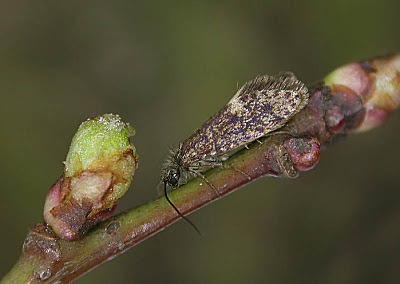2.001 Common Spring Jewel (Dyseriocrania subpurpurella), larva and mine on oak, Lower Scarr Wood, May 20th 2018. A widespread and abundant species almost anywhere there are oaks.
2.001 Common Spring Jewel (Dyseriocrania subpurpurella), North Dean Wood, Apr. 24th 08. A field observation on a Sycamore bud.
2.001 Common Spring Jewel (Dyseriocrania subpurpurella), a mating pair on oak, North Dean Wood, Apr. 6th 09. The heavily spotted, less common form of fastuosella is on the left.
2.001 Common Spring Jewel (Dyseriocrania subpurpurella), Apr.14th 2014. Captured by day at New Lane, Skircoat Green. After nine years with my old Coolpix 4500 I decided it was time for an upgrade so I purchased the Panasonic Lumix FZ200 with the DCR 250 clip-on Raynox lense. It's early days but this shot shows both the fine detail that can be captured and also the very shallow depth of field at the higher end of the zoom - the eye is in focus but not the nose!
2.001 Common Spring Jewel (Dyseriocrania subpurpurella), Bankhouse Wood, Apr. 15th 2014. A field observation on oak.
2.003 White-spotted Spring Jewel (Eriocrania unimaculella), larva and mine on Downy Birch, North Dean Wood, May 17th 2010. Note the two distinctive dark brown spots on the rear of the head capsule. I've found this to be a common leaf miner at this site.
2.003 White-spotted Spring Jewel (Eriocrania unimaculella) larva, May 18th 2010, details above.
Detail of the diagnostic, dark head capsule projections.
2.003 White-spotted Spring Jewel (Eriocrania unimaculella), larva and mine on birch near Hollin Hall at Hardcastle Crags on May 12th 2023.
2.003 White-spotted Spring Jewel (Eriocrania unimaculella), Feb.28th 2011. A freshly emerged moth still drying its wings, hence the uncharacteristic posture. Reared from mines found on Downy Birch the previous May in North Dean Wood.
2.003 White-spotted Spring Jewel (Eriocrania unimaculella), Mar.1st 2011. Reared from mines found in North Dean Wood the previous spring.
2.004 Splendid Spring Jewel (Eriocrania sparrmannella) mine and larva on Downy Birch, Norland Bilberry Slopes, June 28th 2018. Note the initial corridor (to the lower left) is overtaken by the blotch, but remains recognisable in the frass pattern. A much later miner than the more commonly recorded Eriocrania species.
2.004 Splendid Spring Jewel (Eriocrania sparrmannella) mine and larva on birch on the Scout Rock Trail, Mytholmroyd on June 13th 2024.
2.004 Splendid Spring Jewel (Eriocrania sparrmannella) larva from the mine pictured above five days later.
It shows the cloudy, brown spots on the prothorax which helps identify this species.
2.005 Yellow-headed Spring Jewel (Eriocrania salopiella), mine and larva on birch at North Dean Wood, May 23rd 2018.
2.005 Yellow-headed Spring Jewel (Eriocrania salopiella) mine, details above. Two days later and the larva has vacated the mine allowing for the species to be identified.
2.006 Small Spring Jewel (Eriocrania cicatricella), mine and larvae on Downy Birch, North Dean Wood, May 9th 09. The larvae are pale with often more than one to a mine. The mine itself is not completely eaten out giving rise to greenish blotches. A fairly common species at this site.
2.006 Small Spring Jewel (Eriocrania cicatricella), Feb. 27th 09. Reared from mines on Downy Birch found in North Dean Wood the previous May.
2.007 Large Spring Jewel (Eriocrania semipurpurella) larva and mine on Silver Birch, North Dean Wood, May 5th 09. This mid-instar larva will lose the dark sclerotised skin on the head capsule on reaching maturity.
2.007 Large Spring Jewel (Eriocrania semipurpurella) larva and mine on birch near Hollin Hall at Hardcastle Crags on May 12th 2023.
2.007 Large Spring Jewel (Eriocrania semipurpurella) on Feb. 27th 2011. A newly emerged adult reared from mines found in N. Dean Wood the previous spring.
2.007 Large Spring Jewel (Eriocrania semipurpurella) on Mar. 2nd 2011. Reared from mines found last spring in North Dean Wood. The larvae vacated the mines into plant pots containing potting compost and were left outside until the following spring, by which time the pupae contained fully formed adults. The pots were then brought indoors in late February and the adults began to emerge after just 5 days.
2.007 Large Spring Jewel (Eriocrania semipurpurella), Mar. 5th 09. This was reared from mines found the previous spring in North Dean Wood. Perhaps the commonest and most widespread of all the birch feeding Eriocrania, it can occasionally be seen resting on its foodplant on cool, spring days.
2.008 Purple Spring Jewel (Eriocrania sangii), mine and larva on Silver Birch, North Dean Wood, May 4th 09.
2.008 Purple Spring Jewel (Eriocrania sangii) larva on Downy Birch, North Dean Wood, May 4th 09. The opened mine reveals the diagnostic grey larva as well as the "spaghetti" frass typical of Eriocrania species.












%20-%20larva%204..jpg)
%20-%20larva%201..jpg)



..jpg)







..jpg)
2 comments:
Can`t wait,certainly inspired me
Ron
Hi Ron,
The mines on birch are generally easy to find and often produce several species - the adults though are more elusive.
Good luck.
Post a Comment